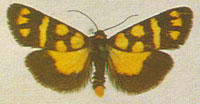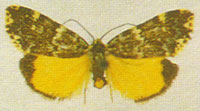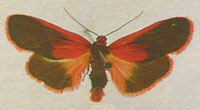Case StudiesAustralian mothsListed below are a number of moth species, found in Australia and which, in the larval stage, eat lichens. Captive larvae may be made to eat foods other than what they would eat naturally. However, for the species listed below there is evidence (or strong suspicion) that the larvae eat lichens in the wild. Some of the species listed below are also found outside Australia but I have given only the Australian distribution. These are small moths, with body lengths between about 5 and 10 millimetres, depending on the species. Cebysa leucotelusThe species is found in southern Australia. The larvae feed on lichens growing on trunks, fence posts or rocks and lichen fragments are incorporated in the larval cases.
Eutane terminalisThis moth is found from central Queensland to southern New South Wales. The larvae can appear in large numbers on the outside walls of older wooden houses and often enter houses (probably in search of pupation sites). Such numbers or activities may cause concern but the larvae are not harmful and feed on the fine lichens that can be found on old woodwork. Heterallactis euchrysaThis species is found between northern New South Wales and Cairns in northern Queensland. Its larvae have been found feeding on lichens growing on the trunks of pawpaw trees.
Halone coryphaea
|
|
Manulea replana
This species is found from southern Queensland to southern New South Wales and feeds on lichens that grow in shady places on rocks or cliff faces.
Narycia basiferana
Narycia cataphracta
|
The larvae of many Narcyia species feed on lichens and make cases which incorporate lichen fragments. Narcyia basiferana is found in New South Wales and southern Queensland while Narcyia cataphracta is found in Victoria, Tasmania and south-east South Australia. The latter is sometimes common in pine plantations where it feeds on the lichens growing on the trees.
Palaeosia bicosta
The species ranges from southern Queensland to Victoria, Tasmania and south-eastern South Australia. The larvae are found on the trunks or branches of various plants and feed on lichens and possibly algae as well.
Procometis bisulcata
The species is found from southern Queensland to South Australia. The larvae live in silk-lined vertical tunnels in the ground. Across the soil surface the larva constructs a soil-encrusted, silken tube that is attached firmly to the tunnel mouth and open at the other end. When not occupied by the larva this tube collapses. At night time the larva takes up position at the tube's open end and browses on terrestrial lichens. The larva also collects lichen fragments which it stores in a chamber just below the soil surface, so giving the larva a food supply for times when conditions are unsuitable for surface browsing.
|
Scoliacma bicolora
This species has been found in north and south Queensland and from there south to Victoria, Tasmania and south-east South Australia. Near Adelaide larvae of this species have been seen eating moss and, less frequently, lichens on rocks in grassy areas.
Sentica felderi
Sentica oppositella
The first species is found in southern Queensland and New South Wales and feeds on the lichens found on sandstone rock faces. The larval cases are ornamented with sand grains. The second species is found from southern Queensland to Victoria. The larvae feed on tree-trunk lichens and construct cases ornamented with lichen fragments.
Xanthodule semiochrea
This species, found from southern Queensland to Victoria, is thought to feed on lichens.
Reference
Common, IFB. (1993, repr. of 1990 ed.). Moths of Australia. Melbourne University Press, Melbourne
The Australian Museum gives some more information about lichen moths here.
![An Australian Government Initiative [logo]](/images/austgovt_brown_90px.gif)






